I was fortunate enough to spend a weekend (29 to 30 July) ‘sponsored by UNESCO’ in Switzerland, thanks in no small part to my Swiss hosts who took me to those famous places.
On the first day, we visited the capital Bern whose Old Town district has been listed as a UNESCO cultural heritage. The shopping area of the Old Town contains a series of undercover walkways that look a bit like cloisters of monasteries or older buildings. There were also basement shops and restaurants that were connected to the ground level by stairs; in residential areas those stairs led to the basement of people’s houses. Another place with picturesque sights can be found along the river Aare which runs through the city. My friends took me to the other side of the river, where we started strolling from the Bärengraben (the Bear Pit which rears several bears, the symbol of Bern) and along the bank until we reached a café/bar by the river. The bar was built out into the waters and had a stage with a glass cover. We spent a leisurely evening there sipping by the stage, enjoying the river scenery while watching the water flow through the glass cover. Afterwards we travelled by train to Brig where my friends lived.
Next morning we set off hiking at the Aletschgletscher (Aletsch Glacier), which is the largest glacier in Switzerland and the whole Alps. The Glacier also formed part of a UNESCO natural heritage. We first took the cable car to a village named Riederalp and started the hike from there. It did not take us long before we caught the first glimpse of the glacier. The view opened up further as we continued on the trail, and I just could not take my eyes off the glacier. This was the first time I saw a glacier. I was expecting the glacier to be like a big slab of ice standing out from its surroundings, but it resembled more a frozen river that meandered through the many valleys with an unfathomable depth. (My friend told me later that the deepest part of the Aletsch Glacier does reach 900 m!) The glacier was so large that we could only see a part of the glacier during our hike. We then climbed over a small peak at Moosfluh and hiked downhill on the other side of the mountain. Before long we reached the town Bettmeralp at the foot of the mountain. It so happened to be their Summer Fest on that day. We took the opportunity to have a break and enjoyed everything on offer there – tasty barbecue, traditional music, nice weather and the lovely view of Bettmersee (Bettmer Lake) against the mountain.
This trip left me with a lasting impression of the natural and cultural scenes so stereotypical of Switzerland. Now that I’ve seen two magnificent sites of UNESCO heritage in a row, my friends joked that I would have higher expectations of my future travels and only demand something better!
我在瑞士的兩天(7月29至30日)有幸到訪兩處聯合國世界遺產,全靠接侍我的兩位朋友。
第一天我的朋友先帶我遊覽首都伯恩(Bern),其舊城區已列為聯合國教科文組織的世界文化遺產。舊城區內的購物區,兩旁的行人道有如修院的走廊,街道也有樓梯通往地庫的商店(住宅區的樓梯則通往一般民居的地庫),挺有特色。伯恩另一個風景區,就是貫通市內的阿勒河(Aare),朋友帶我從舊城區走到河的另一岸,由熊池出發(熊池飼養象徵當地的熊),一直沿着河堤,來到一家在河上搭建的咖啡吧,在那裡坐在一個玻璃台邊,一邊喝東西,一邊欣賞河景,並透過玻璃觀看咖啡吧下的流水,輕鬆地度過一個黃昏。晚上我們坐火車到朋友居住的Brig市。
次日我們一早出發遠足,前住瑞士及全阿爾卑斯山最大的阿勒其冰川(Aletsch Glacier),亦是聯合國教科文組織的世界自然遺產的一部分。我們要先乘吊車到一個名為Riederalp的山村,從那裡沿山路,走了沒多久便見冰川的起端,再走下去,冰川的景色便豁然開朗,不住的吸引我的視線——這是我第一次看到冰川,我還以為冰川是一片又大又高的冰塊,突出於冰天雪地中,但冰川其實更似結了冰的河,蜿蜒穿過一個又一個的山谷,而且深不可測(朋友說最深處有900米),我們今次也祇是看到冰川的一部分。之後我們在Moosfluh攀過一個小山峰,走到另一邊的山坡下山,山腳的小鎮Bettmeralp剛好舉行其夏日慶誌,我們也在那裡歇歇,在燒烤的香味及傳統鄉村樂聲中感受慶誌的歡愉,享受美好的天氣和湖光山色。
今次最令我留下深刻印象的,就是典型的瑞士自然風景及傳統景觀。朋友笑說我一連跑了兩個出色的聯合國世界遺產,他日我對旅遊的要求也會提高吧!
Berne - The Old Town 伯恩舊城區




The shopping area at Marktgasse
位於市集街(Marktgasse)的購物區


The Münster Church
Münster教堂



Münstergasse 教堂街




The distinctive drinking fountains 設計獨特的飲水塔
Top left 左上: Bärenplatz / Top right 右上: Kornhausplatz
Bottom left 左下: Outside Münster Church (The Ten Commandments) Münster教堂外(摩西十戒) / Bottom right 右下: Münstergasse 教堂街




The changing faces of the Parliament (top left) and Bundesplatz (Federal Square) - from a quiet open space (top right), to a protesting ground in mid-afternoon (bottom left) and a fountain in the evening (bottom right)
十八變的國會大樓(左上)及聯邦廣場——由寧靜的公眾地方(右上),下午變為集會場地(左下),到黃昏再搖身一變成噴水池(右下)
Aare River 阿勒河

The view from Bundesterrasse (Federal Terrace)
從聯邦臺遠望的景色


The view from the bridge of Nydegggasse
從Nydegggasse橋上的景色


The houses by the river at Nydeggstalden (left) and Mathenenge (right)
河邊的民居,位於Nydeggstalden (左)及Mathenenge(右)


The Bärengraben (Bear Pit) 熊池



The views along the Aare (Münster Church in the top left)
河岸景色(左上為Münster教堂)

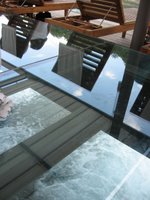
The Schwellenmätteli Restaurant/Bar by the Aare
河畔的Schwellenmätteli餐廳∕咖啡吧
Aletsch Glacier and the local Alps 阿勒其冰川及一帶的阿爾卑斯山
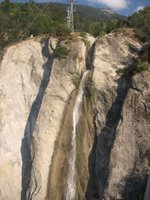

The waterfall (left) and village of Ried-Mörel during the cable car trip uphill
吊車登山途中經過瀑布(左)及Ried-Mörel 村(右)


The village of Riederalp (left) and a youth hostel built in a traditional style (right)
Riederalp村(左)及一家有傳統色彩的旅舍(右)



Mountain views 山色
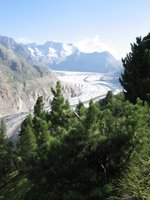

Aletsch Glacier 阿勒其冰川

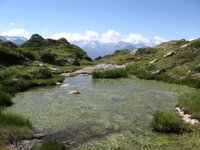
Moosfluh - the cable car station (left) and a marsh nearby (right)
Moosfluh的吊車站(左)及附近的沼澤(右)
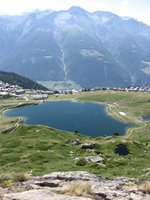

The village of Bettmeralp from the mountains (left) and vice versa (right)
從山上看山下Bettmeralp村(左)及相反方向的景色(右)

Summer Fest at Bettmeralp
Bettmeralp村的夏日慶誌

The flags of the 23 cantons of Switzerland
瑞士23個州的旗幟和國旗

Beautiful scenery, enjoyed by humans and cows alike
秀麗山色,人牛共賞
On the first day, we visited the capital Bern whose Old Town district has been listed as a UNESCO cultural heritage. The shopping area of the Old Town contains a series of undercover walkways that look a bit like cloisters of monasteries or older buildings. There were also basement shops and restaurants that were connected to the ground level by stairs; in residential areas those stairs led to the basement of people’s houses. Another place with picturesque sights can be found along the river Aare which runs through the city. My friends took me to the other side of the river, where we started strolling from the Bärengraben (the Bear Pit which rears several bears, the symbol of Bern) and along the bank until we reached a café/bar by the river. The bar was built out into the waters and had a stage with a glass cover. We spent a leisurely evening there sipping by the stage, enjoying the river scenery while watching the water flow through the glass cover. Afterwards we travelled by train to Brig where my friends lived.
Next morning we set off hiking at the Aletschgletscher (Aletsch Glacier), which is the largest glacier in Switzerland and the whole Alps. The Glacier also formed part of a UNESCO natural heritage. We first took the cable car to a village named Riederalp and started the hike from there. It did not take us long before we caught the first glimpse of the glacier. The view opened up further as we continued on the trail, and I just could not take my eyes off the glacier. This was the first time I saw a glacier. I was expecting the glacier to be like a big slab of ice standing out from its surroundings, but it resembled more a frozen river that meandered through the many valleys with an unfathomable depth. (My friend told me later that the deepest part of the Aletsch Glacier does reach 900 m!) The glacier was so large that we could only see a part of the glacier during our hike. We then climbed over a small peak at Moosfluh and hiked downhill on the other side of the mountain. Before long we reached the town Bettmeralp at the foot of the mountain. It so happened to be their Summer Fest on that day. We took the opportunity to have a break and enjoyed everything on offer there – tasty barbecue, traditional music, nice weather and the lovely view of Bettmersee (Bettmer Lake) against the mountain.
This trip left me with a lasting impression of the natural and cultural scenes so stereotypical of Switzerland. Now that I’ve seen two magnificent sites of UNESCO heritage in a row, my friends joked that I would have higher expectations of my future travels and only demand something better!
我在瑞士的兩天(7月29至30日)有幸到訪兩處聯合國世界遺產,全靠接侍我的兩位朋友。
第一天我的朋友先帶我遊覽首都伯恩(Bern),其舊城區已列為聯合國教科文組織的世界文化遺產。舊城區內的購物區,兩旁的行人道有如修院的走廊,街道也有樓梯通往地庫的商店(住宅區的樓梯則通往一般民居的地庫),挺有特色。伯恩另一個風景區,就是貫通市內的阿勒河(Aare),朋友帶我從舊城區走到河的另一岸,由熊池出發(熊池飼養象徵當地的熊),一直沿着河堤,來到一家在河上搭建的咖啡吧,在那裡坐在一個玻璃台邊,一邊喝東西,一邊欣賞河景,並透過玻璃觀看咖啡吧下的流水,輕鬆地度過一個黃昏。晚上我們坐火車到朋友居住的Brig市。
次日我們一早出發遠足,前住瑞士及全阿爾卑斯山最大的阿勒其冰川(Aletsch Glacier),亦是聯合國教科文組織的世界自然遺產的一部分。我們要先乘吊車到一個名為Riederalp的山村,從那裡沿山路,走了沒多久便見冰川的起端,再走下去,冰川的景色便豁然開朗,不住的吸引我的視線——這是我第一次看到冰川,我還以為冰川是一片又大又高的冰塊,突出於冰天雪地中,但冰川其實更似結了冰的河,蜿蜒穿過一個又一個的山谷,而且深不可測(朋友說最深處有900米),我們今次也祇是看到冰川的一部分。之後我們在Moosfluh攀過一個小山峰,走到另一邊的山坡下山,山腳的小鎮Bettmeralp剛好舉行其夏日慶誌,我們也在那裡歇歇,在燒烤的香味及傳統鄉村樂聲中感受慶誌的歡愉,享受美好的天氣和湖光山色。
今次最令我留下深刻印象的,就是典型的瑞士自然風景及傳統景觀。朋友笑說我一連跑了兩個出色的聯合國世界遺產,他日我對旅遊的要求也會提高吧!
Berne - The Old Town 伯恩舊城區




The shopping area at Marktgasse
位於市集街(Marktgasse)的購物區


The Münster Church
Münster教堂



Münstergasse 教堂街




The distinctive drinking fountains 設計獨特的飲水塔
Top left 左上: Bärenplatz / Top right 右上: Kornhausplatz
Bottom left 左下: Outside Münster Church (The Ten Commandments) Münster教堂外(摩西十戒) / Bottom right 右下: Münstergasse 教堂街




The changing faces of the Parliament (top left) and Bundesplatz (Federal Square) - from a quiet open space (top right), to a protesting ground in mid-afternoon (bottom left) and a fountain in the evening (bottom right)
十八變的國會大樓(左上)及聯邦廣場——由寧靜的公眾地方(右上),下午變為集會場地(左下),到黃昏再搖身一變成噴水池(右下)
Aare River 阿勒河

The view from Bundesterrasse (Federal Terrace)
從聯邦臺遠望的景色


The view from the bridge of Nydegggasse
從Nydegggasse橋上的景色


The houses by the river at Nydeggstalden (left) and Mathenenge (right)
河邊的民居,位於Nydeggstalden (左)及Mathenenge(右)


The Bärengraben (Bear Pit) 熊池



The views along the Aare (Münster Church in the top left)
河岸景色(左上為Münster教堂)


The Schwellenmätteli Restaurant/Bar by the Aare
河畔的Schwellenmätteli餐廳∕咖啡吧
Aletsch Glacier and the local Alps 阿勒其冰川及一帶的阿爾卑斯山


The waterfall (left) and village of Ried-Mörel during the cable car trip uphill
吊車登山途中經過瀑布(左)及Ried-Mörel 村(右)


The village of Riederalp (left) and a youth hostel built in a traditional style (right)
Riederalp村(左)及一家有傳統色彩的旅舍(右)



Mountain views 山色


Aletsch Glacier 阿勒其冰川


Moosfluh - the cable car station (left) and a marsh nearby (right)
Moosfluh的吊車站(左)及附近的沼澤(右)


The village of Bettmeralp from the mountains (left) and vice versa (right)
從山上看山下Bettmeralp村(左)及相反方向的景色(右)

Summer Fest at Bettmeralp
Bettmeralp村的夏日慶誌

The flags of the 23 cantons of Switzerland
瑞士23個州的旗幟和國旗

Beautiful scenery, enjoyed by humans and cows alike
秀麗山色,人牛共賞
Comments
hope things are going well, esp work, in between your holidays ;-)